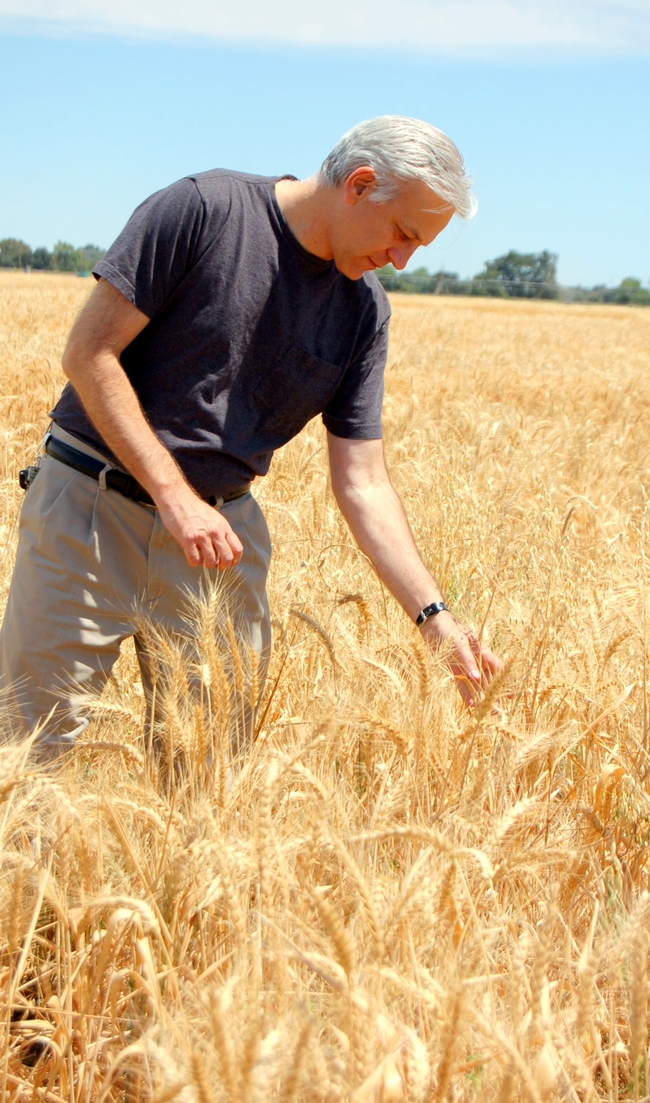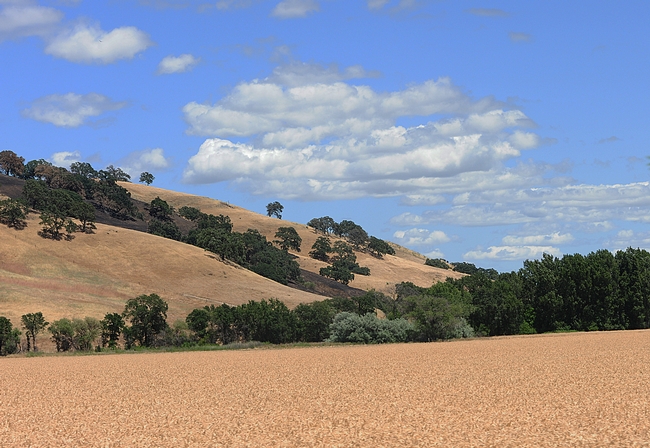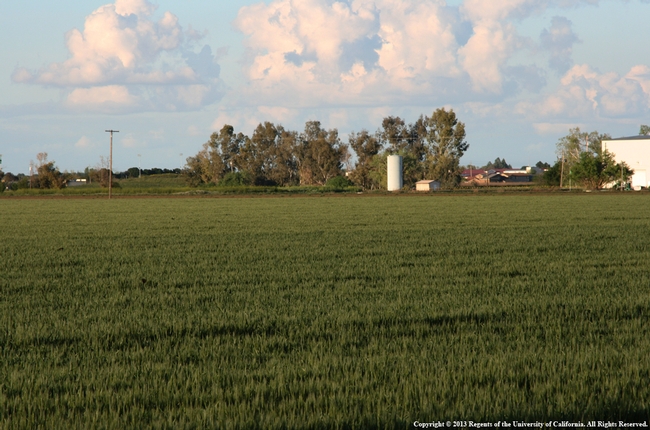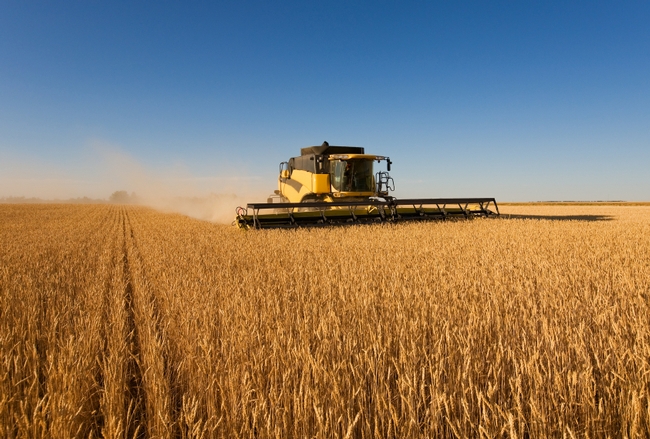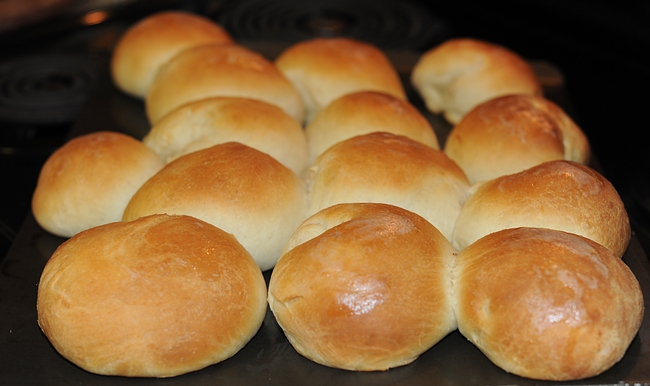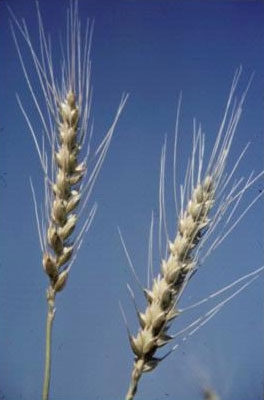Posts Tagged: wheat
Wheat: What’s behind the 'Amber Waves of Grain'
When you think of “amber waves of grain,” do you think of wheat?
You should. It's not only part of “America, the Beautiful,” (lyrics penned in 1893 by Wellesley College professor Katharine Lee Bates), but it's part of California's agricultural landscape.
California annually grows about 800,000 acres of wheat, with about half used for human consumption and the rest for animal feed. It's a highly sustainable rotational crop.
Wheat growers seed the crop in the fall and winter, and harvest it in late spring or early summer. That's when we see the “amber waves of grain.” In the winter, weather conditions permitting, it's emerald green.
Since this cereal crop relies heavily on winter rainfall, it minimizes the use of our limited ground and surface water. However, acreage will likely be down this year due to our drought conditions. In non-drought years, the thick lawn-like plantings help reduce soil erosion and increases water infiltration.
Our state's yields are impressive, averaging 2.5 to 4.5 tons per acre, twice the national average of 1.3 tons per acre. California primarily produces hard red varieties that have excellent milling and baking characteristics. With high protein levels at 12 to 15 percent, California wheat is especially favorable for bread making.
Wheat is a fairly pest- and disease-resistant crop. Varieties developed by UC Davis researchers and other scientists at public universities and private seed companies combat serious diseases like stripe rust and barley yellow dwarf viruses that have cost growers millions of dollars in yield losses. Researchers rely solely on crosses with different ancestral wheat varieties using sophisticated molecular markers. These crosses are not genetically engineered; in fact, there are no genetically modified wheat varieties on the market.
Not only is wheat sustainably grown, but whole wheat grain is a nutritious and a healthy part of the human diet covering thousands of years. Wheat grain is an important source of protein, starch, fiber, vitamins and nutrients that give us energy and help prevent cardiovascular disease, diabetes and cancer. It also has higher protein content than other major cereals such as corn and rice.
Wheat is also good habitat for beneficial insects such as ladybird beetles and lacewings. These natural enemies help keep aphid pests under good biological control so growers rarely need insecticides for wheat production in California. Wheat additionally provides habitat for colonies of endangered tricolored blackbirds.
After growers harvest the grain, they cut and bale the leftover dry stalks, known as wheat straw, for livestock bedding, especially for horses at racetracks. When the bedding is spent, the wheat straw, mixed with manure, is recycled into compost. Major end users include the mushroom farms in the Monterey and Bay areas, which rank second in the nation in mushroom production.
So, the next time you hear or sing “America the Beautiful” (“O beautiful for spacious skies, For amber waves of grain…”), stop and think of California wheat and its many uses.
That includes breads, pizza, pasta and pastries, but also alcoholic beverages (wheat is a key ingredient in some beers).
What's to eat? Wheat. Whether it's emerald green or amber, as in “amber waves of grain,” it helps define and strengthen our agricultural landscape, our heritage, our uses and our future.
Click here to find the recipe for Kathy's rolls.
An initiative to enhance competitive and sustainable food systems is part of the UC Division of Agriculture and Natural Resources Strategic Vision 2025.
GMO fight in southern Oregon sharpens GMO debate in California
"We could do millions of things with transgenics, but we have our hands tied," a story in The Scientist quoted Jorge Dubcovsky, professor in the Department of Plant Sciences at UC Davis.
Dubcovsky commented in The Scientist article about his work in using biotechnology to instill resistance to a devastating plant disease, stripe rust, in wheat.
“Wheat is a very important cereal,” says Ravi Singh of Irrigated Bread Wheat Improvement and Rust Research in Mexico. “Twenty percent of [humans'] calories and about the same [percent of] protein are coming from wheat.”
Genetic engineering is a way to breed long-lasting stem rust–resistant wheat varieties and boost wheat yields around the world. But genetically modified foods are being kept off the market by public opposition and regulatory expenses.
The Scientist article, written by Kerry Grens, said a few groups are forging ahead, including Dubcovsky and other researchers who are cloning stripe rust-resistance genes from wheat and other taxa and identify their functions. For more on Dubcovsky's work, see UC researchers improve wheat nutrition and yield.
New funding to study wheat and forest genetics
Roger Beachy, the director of the USDA National Institute of Food and Agriculture, was at UC Davis yesterday to announce grants for agricultural research amounting to $40 million, calling them "significant investments," said a UC Davis news release.
Together with UC Davis officials, Beachy announced that:
- Wheat geneticist Jorge Dubcovsky will receive $25 million to develop new varieties of wheat and barley. Dubcovsky and his 55 university and USDA colleagues will focus on biological and environmental stresses to wheat that are caused, at least in part, by global climate change.
- Forest geneticist David Neale will receive $14.6 million to head a team that will work to sequence the genomes of loblolly pine and two other conifers. Neale and his research colleagues plan to accelerate breeding efforts for fast-growing varieties of these trees to enhance their use as feedstocks for biofuels and biopower.
"We look forward to the practical solutions for agriculture and for the environment that will arise from these collaborative projects," UC Davis Chancellor Linda Katehi said at the press conference.
A story about the grants written by Rick Daysog of the Sacramento Bee said they come as UC Davis has stepped up efforts to attract research grants following Katehi's appointment as chancellor in 2009. During its fiscal year ending June 30, 2010, the university received a record $679 million in research grants.

Left to right: David Neale, Jorge Dubcovsky, Linda Katehi, Roger Beachy, Neal Van Alfen.
Rainy season was good for valley wheat growers
The rainy season of 2009-10 was good news for San Joaquin Valley wheat farmers, according to an article in Western Farm Press.
It was the wettest growing season in the past five years, wrote reporter Harry Cline. Central Valley dryland producers are happy; coastal and Delta farmers, however, got too much rain, which cut early production.Cline gathered the information at a UC Cooperative Extension cereal field day in Tulare County. At the field day, UCCE farm advisor Steve Wright said the rain saved growers two 4-inch irrigations.
“That is huge — saving 8 inches of water,” Wright was quoted.
One concern that arises in wet weather is stripe rust, but it caused more damage in triticale than wheat this year.
“All PCAs and growers were watching for stripe rust this year since it was projected to be a bad rust year. There were hits, but it never took off and blew up like it did in 2003,” Wright was quoted in the article. “Newer varieties still have pretty good resistance and some fungicides went on, but overall it was not that bad. Even in the Sacramento Valley, stripe rust did not take off as expected this year.”

Wheat foliage damaged by stripe rust.


